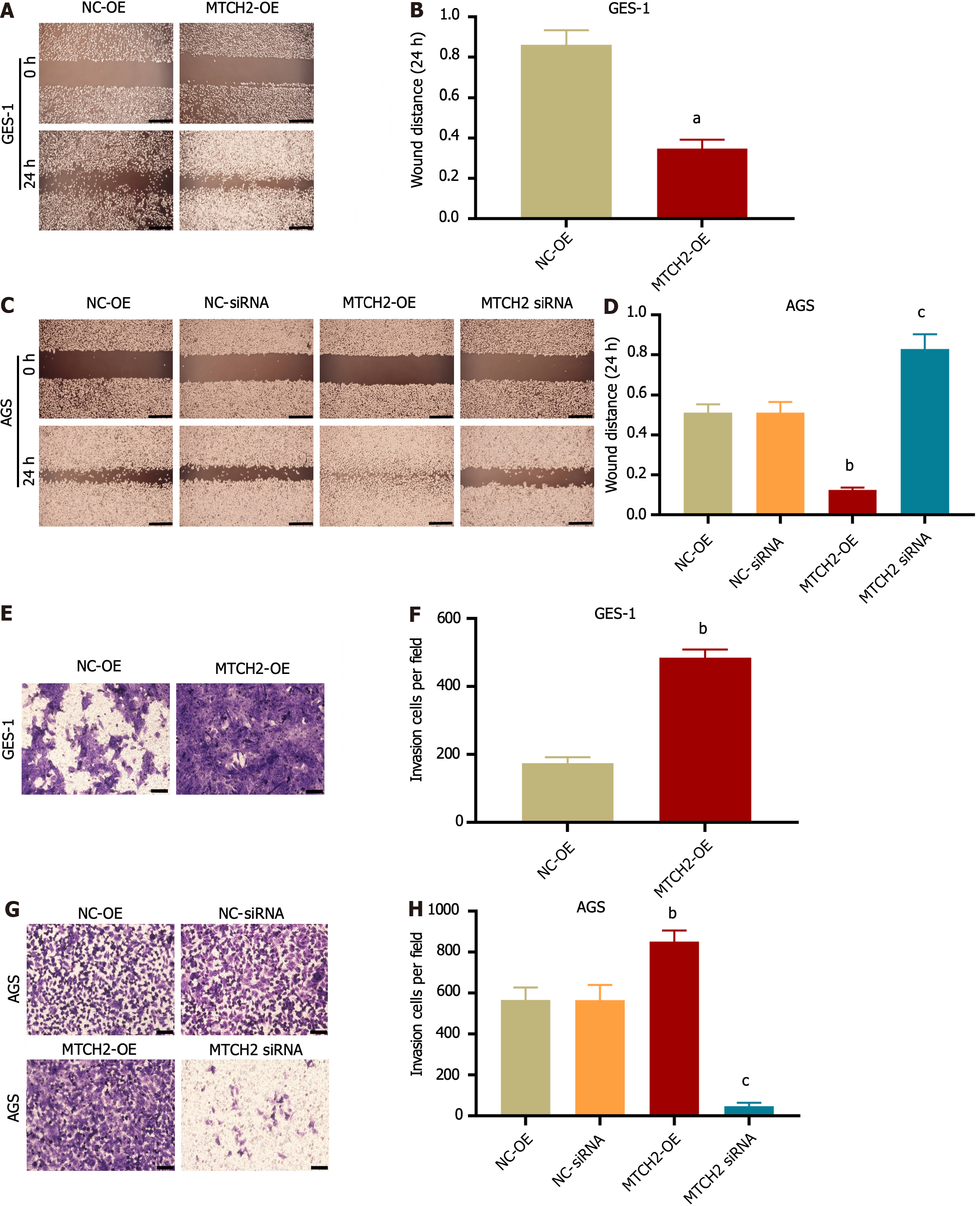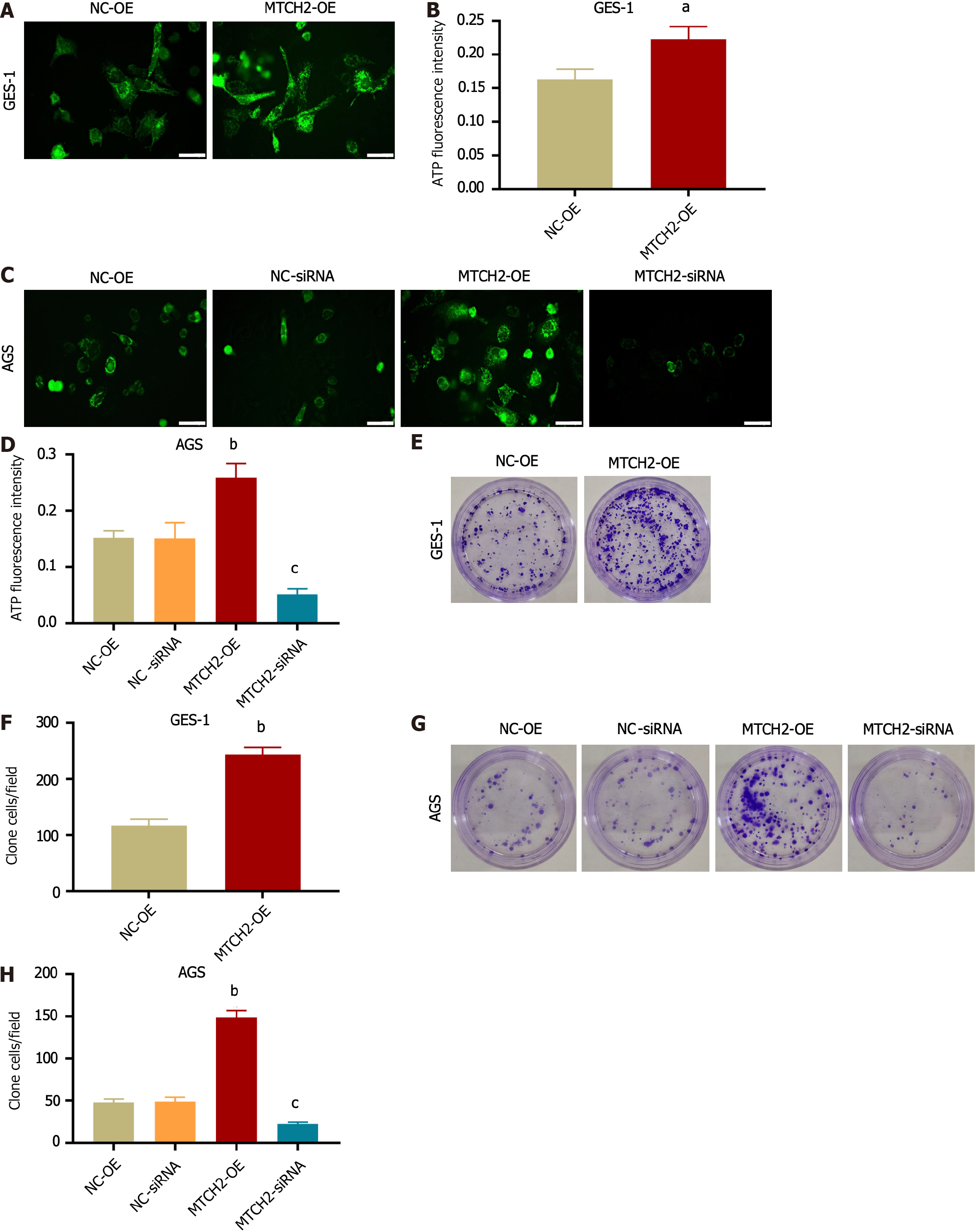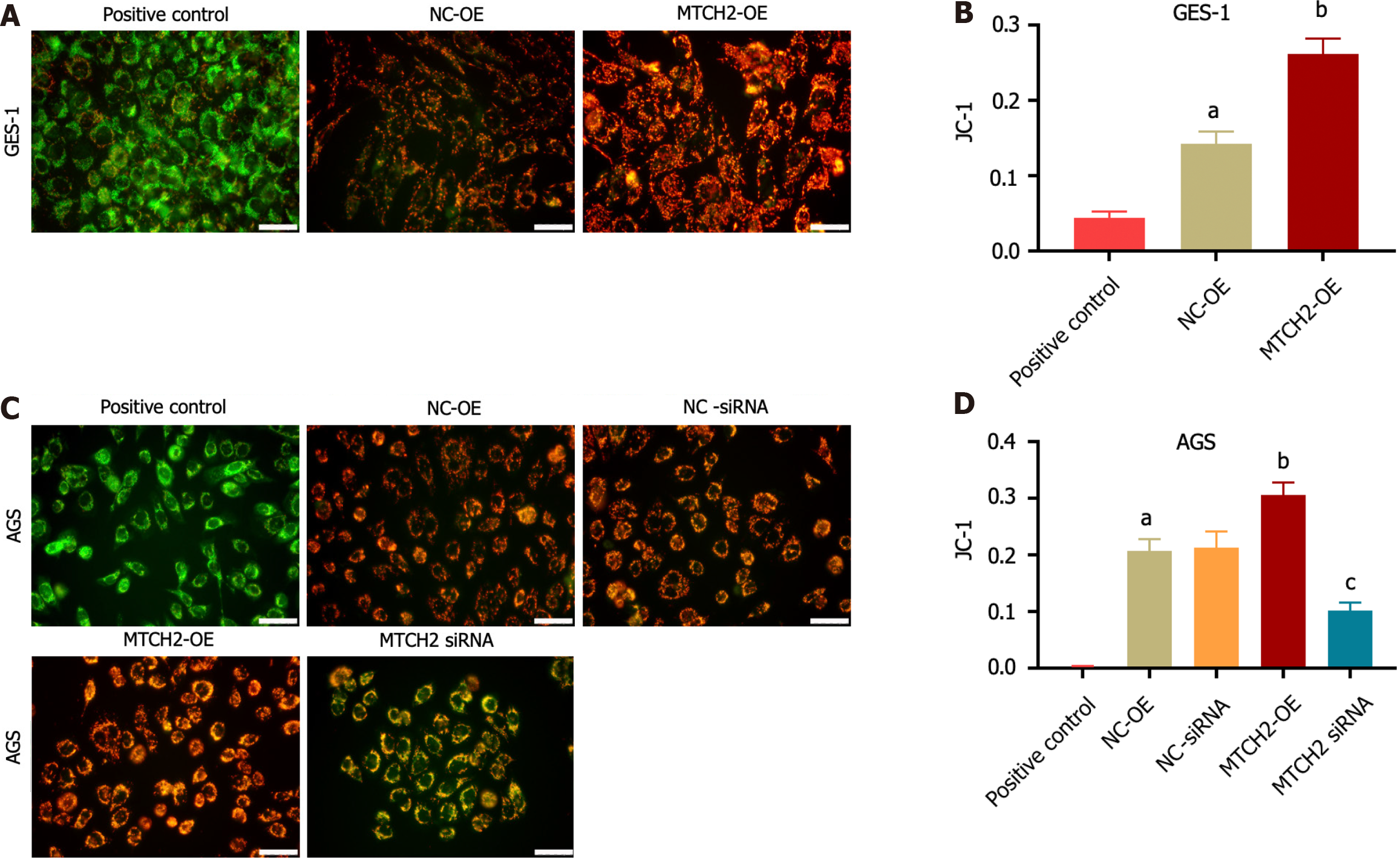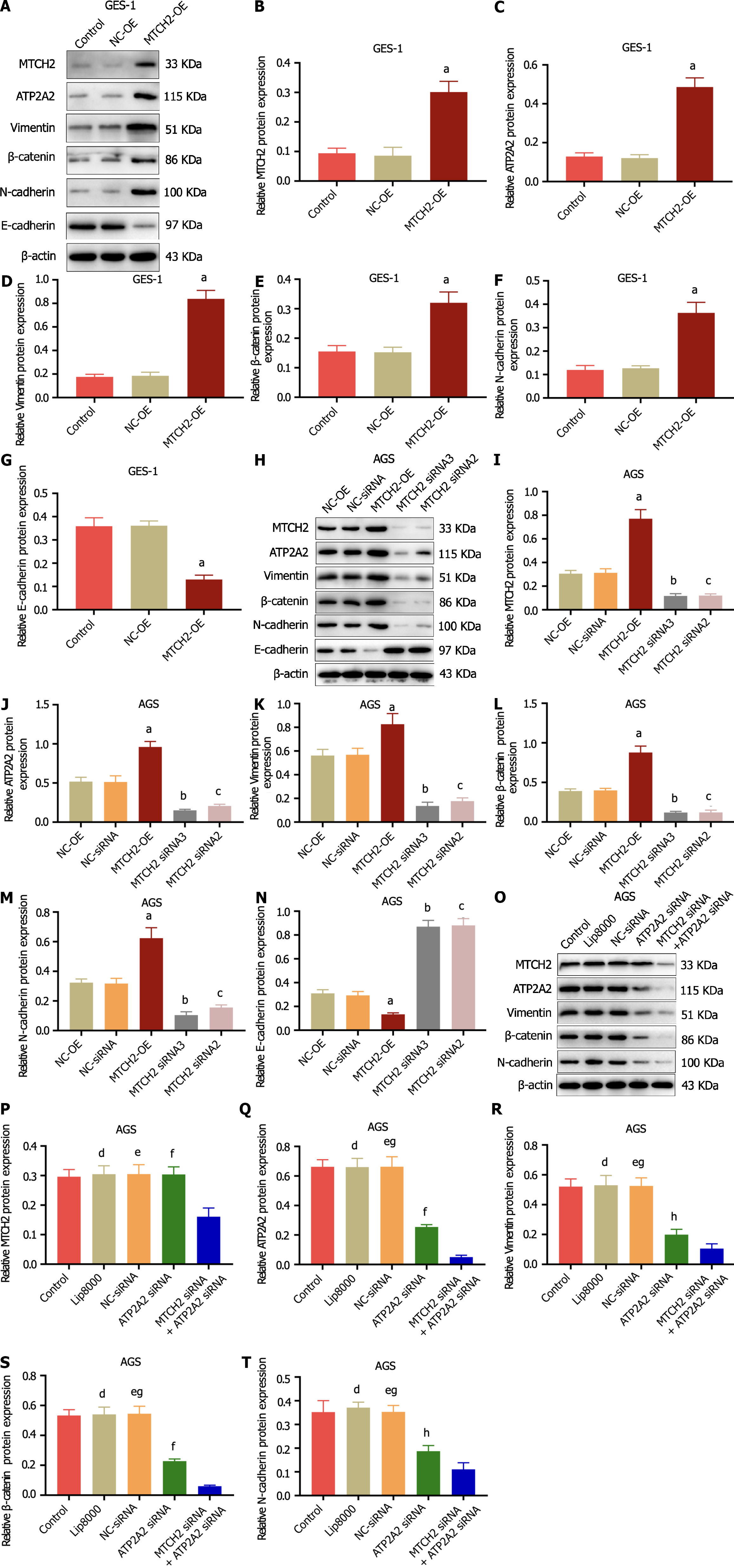Copyright
©The Author(s) 2024.
World J Gastrointest Oncol. Mar 15, 2024; 16(3): 991-1005
Published online Mar 15, 2024. doi: 10.4251/wjgo.v16.i3.991
Published online Mar 15, 2024. doi: 10.4251/wjgo.v16.i3.991
Figure 1 The expression difference of mitochondrial carrier homolog 2 in gastric cancer and paracancer tissues.
A: Gene Expression Profiling Interactive Analysis (GEPIA) was used to analyze the expression of mitochondrial carrier homolog 2 (MTCH2) (left) and MTCH1 (right) in stomach adenocarcinoma; B-D: Expression of MTCH2 and ATP2A2 in gastric cancer tissues and paracarcinoma tissues, n = 65; E-J: MTCH2-OE and MTCH2-siRNA transfection were validated by Western blotting (scale bar: 50 μm). MTCH: Mitochondrial carrier homolog; STAD: Stomach adenocarcinoma; GES-1: Human gastric epithelial cells; AGS: Human gastric cancer cells. aP < 0.001, compared with gastric cancer; bP < 0.001, compared with NC-OE; cP < 0.001, dP < 0.001, compared with NC-siRNA.
Figure 2 Effects of mitochondrial carrier homolog 2 on invasion and migration of human gastric mucosal cells and human gastric cancer cells.
A and C: Migration of human gastric mucosal cell (GES-1) and human gastric cancer cells (AGS) was detected by scratch wound healing assay; B and D: Ratio of 24 h to 0 h wound distance, (scale bar: 400 μm); E and G: Invasion ability of GES-1 and AGS cells was detected by transwell; F and H: The number of cells invaded in random fields of view (scale bar: 50 μm). MTCH2: Mitochondrial carrier homolog 2; siRNA: Small interfering RNA; OE: Overexpression; NC-OE: Negative control of overexpression; NC-siRNA: Negative control of siRNA; GES-1: Human gastric mucosal cell; AGS: Human gastric cancer cells. aP < 0.01, bP < 0.001, compared with NC-OE; cP < 0.001, compared with NC-siRNA.
Figure 3 Mitochondrial carrier homolog 2 regulates mitochondrial ATP production.
A and C: ATP concentration of human gastric mucosal cell (GES-1) and human gastric cancer cells (AGS) were detected through pcMV-AT1.03 plasmid transfection; B and D: Quantification of ATP fluorescence intensity (scale bar: 50 μm); E and G: Detection of the proliferation of GES-1 and AGS cells after by colony formation assay; F and H: Number of cell colonies in different groups. MTCH2: Mitochondrial carrier homolog 2; siRNA: Small interfering RNA; OE: Overexpression; NC-OE: Negative control of overexpression; NC-siRNA: Negative control of siRNA; GES-1: Human gastric mucosal cell; AGS: Human gastric cancer cells. aP < 0.05, bP < 0.001 compared with NC-OE; cP < 0.001, compared with NC-siRNA.
Figure 4 Mitochondrial carrier homolog 2 regulates the level of mitochondrial membrane potential.
A and C: Mitochondrial membrane potential level of human gastric mucosal cell and human gastric cancer cells were detected by JC-1 staining; B and D: Quantification of JC-1 fluorescence intensity (scale bar: 50 μm). MTCH2: Mitochondrial carrier homolog 2; siRNA: Small interfering RNA; OE: Overexpression; NC-OE: Negative control of overexpression; NC-siRNA: Negative control of siRNA; GES-1: Human gastric mucosal cell; AGS: Human gastric cancer cells. aP < 0.001, compared with positive control; bP < 0.001, compared with NC-OE; cP < 0.001, compared with NC-siRNA.
Figure 5 Mitochondrial carrier homolog 2 regulates the opening of mitochondrial permeability transition pore and expression of apoptosis-related proteins.
A and C: The opening of mitochondrial permeability transition pore (mPTP) channels in human gastric mucosal cell (GES-1) and human gastric cancer cells (AGS) were detected by Calcein AM staining; B and D: Quantification of mPTP fluorescence intensity (scale bar: 50 μm); E-H: The expression level of Bax (E and F), Bcl-2 (E and G), and Cyto c (E and H) in mitochondrial carrier homolog 2 (MTCH2) overexpressed and MTCH2 silenced GES-1 cells were detected by Western blotting; I-L: The expression level of Bax (I and J), Bcl-2 (I and K), and Cyto c (I and L) in MTCH2 overexpressed and MTCH2 silenced AGS cells were detected by Western blotting. mPTP: Mitochondrial permeability transition pore; MTCH2: Mitochondrial carrier homolog 2; siRNA: Small interfering RNA; OE: Overexpression; NC-OE: Negative control of overexpression; NC-siRNA: Negative control of siRNA; GES-1: Human gastric mucosal cell; AGS: Human gastric cancer cells. aP < 0.001, cP < 0.01, compared with NC-OE; bP < 0.001, compared with NC-siRNA.
Figure 6 The expression of mitochondrial carrier homolog 2 and ATP2A2 is involved in the malignant phenotype of gastric epithelial cells and the metastasis of human gastric cancer cells.
A-G: After mitochondrial carrier homolog 2 (MTCH2)-OE plasmid was transfected into gastric epithelial cells, changes of the expression level of MTCH2, ATP2A2, Vimentin, β-catenin, N-cadherin, and E-cadherin were detected; H-N: After human gastric cancer cells (AGS) were transfected with MTCH2-OE, MTCH2 siRNA3 and MTCH2 siRNA2, the expression level of MTCH2, ATP2A2, Vimentin, β-catenin, N-cadherin, and E-cadherin were detected by Western blotting; O-T: After AGS cells were transfected with MTCH2-siRNA or ATP2A2 siRNA, the expression level of MTCH2, ATP2A2, Vimentin, β-catenin, and N-cadherin were detected by Western blotting. NS: No significant; aP < 0.001, compared with NC-OE; bP < 0.001, cP < 0.001, compared with NC-siRNA; dP < 0.001, eP < 0.001, fP < 0.001, hP < 0.05, compared with MTCH2 siRNA + ATP2A2 siRNA; gP < 0.001, compared with ATP2A2 siRNA.
- Citation: Zhang JW, Huang LY, Li YN, Tian Y, Yu J, Wang XF. Mitochondrial carrier homolog 2 increases malignant phenotype of human gastric epithelial cells and promotes proliferation, invasion, and migration of gastric cancer cells. World J Gastrointest Oncol 2024; 16(3): 991-1005
- URL: https://www.wjgnet.com/1948-5204/full/v16/i3/991.htm
- DOI: https://dx.doi.org/10.4251/wjgo.v16.i3.991














